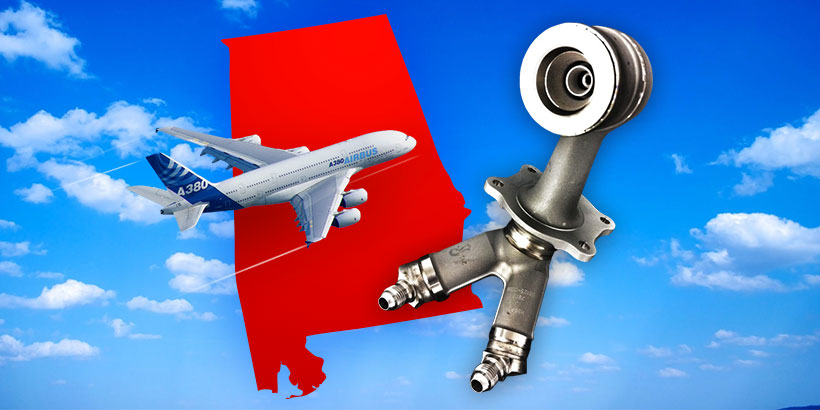
AUBURN, Ala. — GE Aviation is turning its facility in Auburn into the world’s first factory for 3-D printed jet engine fuel nozzles, landing the Alabama plant a starring role in a technology that promises to revolutionize aerospace manufacturing.
GE Aviation, one of the world’s top aircraft engine producers, announced plans to introduce high-volume production of the fuel nozzle using additive manufacturing in Auburn at last year’s Farnborough International Airshow. The company said the $50 million project would make the Alabama plant the first to mass produce 3-D printed components for the jet propulsion industry.
Joe Markiewicz, plant manager in Auburn, says the project is moving ahead on schedule, with quality and engineering requirements being met as a prelude to full-scale production. The company plans to have 10 printing machines installed at the 300,000-square-foot facility by year’s end, a figure that could eventually climb to as many as 50.
“Our plan is still to begin production late in 2015 for LEAP fuel nozzles,” Markiewicz said.
The next-generation LEAP engine, being developed through a partnership between GE and France’s Snecma (Safran), promises improved fuel efficiency for air carriers. Variants will be used on the Chinese COMAC C919, the Boeing 737 Max and the Airbus A320neo, which will be assembled at the company’s new Alabama manufacturing facility.
The LEAP has already racked up more than 8,650 orders and commitments for CFM International, as the joint venture is known. FAA-certification of the engine is expected later this year.
40,000 NOZZLES PER YEAR
Since there are 19 fuel nozzles in every LEAP engine, GE Aviation said the stage is set for large-scale, long-term production at the Auburn plant. In March, the company said production there will ramp up quickly over the next five years, going from 1,000 fuel nozzles manufactured annually to more than 40,000 by 2020.
“Fuel nozzles are an intricate and highly sophisticated engine component that are key to delivering industry-leading fuel efficiency and lower emissions for next-generation jet engines,” the company said.
Greg Canfield, secretary of the Alabama Department of Commerce, said the GE Aviation additive manufacturing project is an indicator of the high-level capabilities of Alabama’s robust aviation and aerospace sector. With Airbus launching production of A320 Family passenger jets in Mobile this year, those capabilities span almost the entire spectrum of industry activities, from research to aircraft assembly.
“Alabama has a long history in aerospace and aviation, but the future looks even brighter thanks to cutting-edge projects like the one being carried out by GE Aviation in Auburn,” Canfield said. “Our aerospace and aviation sector is poised to reach new altitudes in coming years as major industry players expand their Alabama operations.”
AIR SHOW GENESIS
Plans for the additive manufacturing facility in Auburn were first discussed at the 2013 Paris Air Show when GE Aviation CEO David Joyce met with Alabama Governor Robert Bentley, Secretary Canfield and Auburn Mayor Bill Ham Jr. Joyce and the Alabama team talked about what the next generation of technology would look like and how the Auburn facility could fit into that.
Additive manufacturing is viewed as the next major technological development that will shake up the aerospace industry. Additive manufacturing involves the “printing” of 3-D metallic parts, which are built up layer by layer from a powdered material. Traditional manufacturing involves techniques such as machining and welding.
GE Aviation says it has spent the last several years developing technologies ranging from data analysis to machine monitoring and preventive maintenance to get its 3-D printing techniques ready for mass production.
The new 3-D printed nozzle is 25 percent lighter and as much as five times more durable than the current nozzle made from 20 different parts.
“There are really a lot of benefits to building things through additive,” said Matt Benvie, spokesman for GE Aviation. “You get speed because there’s less need for tooling and you go right from a model or idea to making a part. You can also get geometries that just can’t be made any other way.”
Employment at the Auburn plant, which totaled 70 at the time of the Farnborough announcement, has risen to 120 today, Markiewicz said. GE Aviation opened the Auburn facility in early 2013 to manufacture high-pressure turbine airfoils for jet engines.
Since arriving in Alabama, the company has begun developing ties to Auburn University, which is seen as a potential talent pipeline for the facility. “We continue working with Auburn University around technology, student activities, and recruiting, and the partnership continues to grow,” Markiewicz said.
Don’t miss out! Subscribe today to have Alabama’s leading headlines delivered to your inbox.